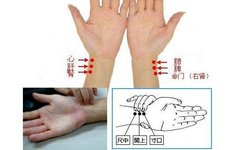The cun, guan, and chi of the left hand correspond to the heart, liver, and kidneys of the human body; the cun, guan, and chi of the right hand correspond to the lungs, spleen, and mingmen (Gate of Life).
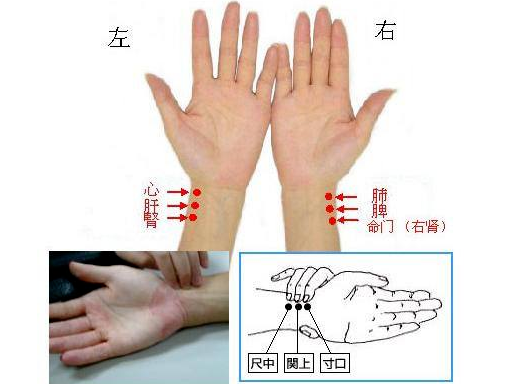 Floating Pulse (Fu Mai)
Floating Pulse (Fu Mai)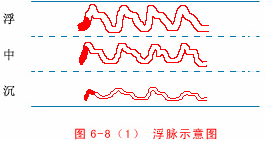 【Body Image Song】Floating on the skin, like wood floating on water; it is abundant when lifted, insufficient when pressed.【Main Disease Song】Floating pulse is yang, its disease is on the surface. Floating at cun indicates wind; floating at left guan indicates wind in the middle jiao; floating at right guan indicates wind-phlegm in the diaphragm; floating at chi indicates wind in the lower jiao, with difficulty in urination and constipation.【Combined Pulse Song】Weak indicates exterior deficiency, strong indicates exterior excess. Floating tight indicates wind-cold, floating slow indicates wind-stroke; floating rapid indicates wind-heat, floating slow indicates wind-damp. Floating hollow indicates blood loss, floating short indicates qi deficiency; floating surging indicates empty heat, floating empty indicates summer heat fatigue; floating rough indicates blood injury, floating moist indicates qi failure. ☞ Deep Pulse (Chen Mai)
【Body Image Song】Floating on the skin, like wood floating on water; it is abundant when lifted, insufficient when pressed.【Main Disease Song】Floating pulse is yang, its disease is on the surface. Floating at cun indicates wind; floating at left guan indicates wind in the middle jiao; floating at right guan indicates wind-phlegm in the diaphragm; floating at chi indicates wind in the lower jiao, with difficulty in urination and constipation.【Combined Pulse Song】Weak indicates exterior deficiency, strong indicates exterior excess. Floating tight indicates wind-cold, floating slow indicates wind-stroke; floating rapid indicates wind-heat, floating slow indicates wind-damp. Floating hollow indicates blood loss, floating short indicates qi deficiency; floating surging indicates empty heat, floating empty indicates summer heat fatigue; floating rough indicates blood injury, floating moist indicates qi failure. ☞ Deep Pulse (Chen Mai)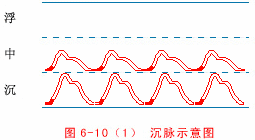 【Body Image Song】Deep travels through the muscles and bones, like a stone thrown into water; it is abundant when pressed, insufficient when lifted.【Main Disease Song】Deep pulse is yin, its disease is internal. Deep at cun indicates shortness of breath, chest pain radiating to the ribs; it may be phlegm or fluid. Guan indicates internal cold, causing pain and knots; it may be fullness and oppression, with acid reflux and tense muscles. Chi indicates back pain, also affecting the knees; dampness and itching below.【Combined Pulse Song】Weak indicates internal deficiency, strong indicates internal excess. Deep slow indicates chronic cold, deep rapid indicates internal heat; deep slippery indicates phlegm or fluid, deep rough indicates blood stasis; deep weak indicates deficiency, deep firm indicates accumulation; deep tight indicates cold pain, deep slow indicates damp-cold.☞ Slow Pulse (Chi Mai)
【Body Image Song】Deep travels through the muscles and bones, like a stone thrown into water; it is abundant when pressed, insufficient when lifted.【Main Disease Song】Deep pulse is yin, its disease is internal. Deep at cun indicates shortness of breath, chest pain radiating to the ribs; it may be phlegm or fluid. Guan indicates internal cold, causing pain and knots; it may be fullness and oppression, with acid reflux and tense muscles. Chi indicates back pain, also affecting the knees; dampness and itching below.【Combined Pulse Song】Weak indicates internal deficiency, strong indicates internal excess. Deep slow indicates chronic cold, deep rapid indicates internal heat; deep slippery indicates phlegm or fluid, deep rough indicates blood stasis; deep weak indicates deficiency, deep firm indicates accumulation; deep tight indicates cold pain, deep slow indicates damp-cold.☞ Slow Pulse (Chi Mai)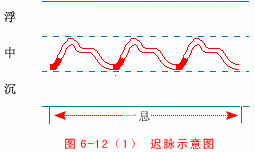 【Body Image Song】Slow pulse belongs to yin, characterized by insufficiency; it comes and goes slowly, three beats to one breath.【Main Disease Song】Slow pulse indicates organ issues, its disease is cold. Slow at cun indicates upper cold, heart pain and stagnation; slow at guan indicates middle cold, with knots and spasms; slow at chi indicates fire deficiency, with incontinence or pain in the lower abdomen.【Combined Pulse Song】Strong indicates accumulation of cold, weak indicates deficiency of cold. Floating slow indicates exterior cold, deep slow indicates internal cold; slow rough indicates blood deficiency, slow soft indicates damp-cold; slow slippery indicates fullness and distension, slow weak indicates difficulty in settling.☞ Rapid Pulse (Shu Mai)
【Body Image Song】Slow pulse belongs to yin, characterized by insufficiency; it comes and goes slowly, three beats to one breath.【Main Disease Song】Slow pulse indicates organ issues, its disease is cold. Slow at cun indicates upper cold, heart pain and stagnation; slow at guan indicates middle cold, with knots and spasms; slow at chi indicates fire deficiency, with incontinence or pain in the lower abdomen.【Combined Pulse Song】Strong indicates accumulation of cold, weak indicates deficiency of cold. Floating slow indicates exterior cold, deep slow indicates internal cold; slow rough indicates blood deficiency, slow soft indicates damp-cold; slow slippery indicates fullness and distension, slow weak indicates difficulty in settling.☞ Rapid Pulse (Shu Mai)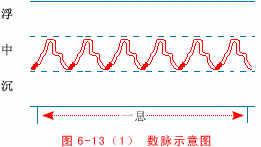 【Body Image Song】Rapid pulse belongs to yang, characterized by excess; one breath six beats, coming and going frequently.【Main Disease Song】Rapid pulse indicates issues with the fu organs, its disease is heat. Rapid at cun indicates wheezing and coughing, mouth sores in the lungs; rapid at guan indicates stomach heat, with evil fire attacking upwards; rapid at chi indicates heart fire, with incontinence and turbid urination.【Combined Pulse Song】Strong indicates excess fire, weak indicates deficiency fire. Floating rapid indicates exterior heat, deep rapid indicates internal heat. Yang rapid indicates fire excess, yin rapid indicates heart fire. Right rapid indicates excess fire, left rapid indicates yin injury.☞ Slippery Pulse (Hua Mai)
【Body Image Song】Rapid pulse belongs to yang, characterized by excess; one breath six beats, coming and going frequently.【Main Disease Song】Rapid pulse indicates issues with the fu organs, its disease is heat. Rapid at cun indicates wheezing and coughing, mouth sores in the lungs; rapid at guan indicates stomach heat, with evil fire attacking upwards; rapid at chi indicates heart fire, with incontinence and turbid urination.【Combined Pulse Song】Strong indicates excess fire, weak indicates deficiency fire. Floating rapid indicates exterior heat, deep rapid indicates internal heat. Yang rapid indicates fire excess, yin rapid indicates heart fire. Right rapid indicates excess fire, left rapid indicates yin injury.☞ Slippery Pulse (Hua Mai)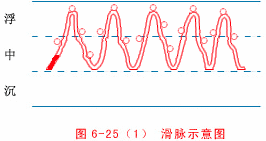 【Body Image Song】Slippery pulse flows smoothly, coming and going easily; it resembles the shape of beads, embodying the essence of dew.【Main Disease Song】Slippery pulse is yang, often indicating phlegm and fluids. Slippery at cun indicates cough; fullness in the chest and nausea; slippery at guan indicates stomach heat, with obstructed qi and food injury; slippery at chi indicates urinary issues, or may indicate dysentery or blood in urine.【Combined Pulse Song】Floating slippery indicates wind-phlegm, deep slippery indicates phlegm-food. Slippery rapid indicates phlegm-fire, slippery short indicates qi obstruction. Slippery and floating indicates pain in urination; slippery and floating indicates stroke paralysis. Slippery and harmonious indicates pregnancy can be determined.☞ Rough Pulse (Se Mai)
【Body Image Song】Slippery pulse flows smoothly, coming and going easily; it resembles the shape of beads, embodying the essence of dew.【Main Disease Song】Slippery pulse is yang, often indicating phlegm and fluids. Slippery at cun indicates cough; fullness in the chest and nausea; slippery at guan indicates stomach heat, with obstructed qi and food injury; slippery at chi indicates urinary issues, or may indicate dysentery or blood in urine.【Combined Pulse Song】Floating slippery indicates wind-phlegm, deep slippery indicates phlegm-food. Slippery rapid indicates phlegm-fire, slippery short indicates qi obstruction. Slippery and floating indicates pain in urination; slippery and floating indicates stroke paralysis. Slippery and harmonious indicates pregnancy can be determined.☞ Rough Pulse (Se Mai)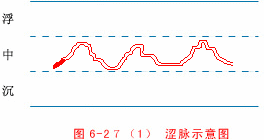 【Body Image Song】Rough pulse is stagnant, like a knife scraping bamboo; it is slow and thin, three signs of fear.【Main Disease Song】Rough indicates blood deficiency, also indicating essence injury. Rough at cun indicates heart pain, or palpitations; rough at guan indicates yin deficiency, leading to internal heat; right guan indicates earth deficiency, left guan indicates rib distension. Rough at chi indicates urinary issues, blood in stool; pregnancy indicates fetal issues, with blood loss.【Combined Pulse Song】Rough and firm indicates excess heat; rough and soft indicates deficiency fire.☞ Weak Pulse (Xu Mai)
【Body Image Song】Rough pulse is stagnant, like a knife scraping bamboo; it is slow and thin, three signs of fear.【Main Disease Song】Rough indicates blood deficiency, also indicating essence injury. Rough at cun indicates heart pain, or palpitations; rough at guan indicates yin deficiency, leading to internal heat; right guan indicates earth deficiency, left guan indicates rib distension. Rough at chi indicates urinary issues, blood in stool; pregnancy indicates fetal issues, with blood loss.【Combined Pulse Song】Rough and firm indicates excess heat; rough and soft indicates deficiency fire.☞ Weak Pulse (Xu Mai)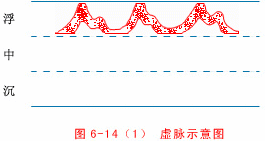 【Body Image Song】Weak pulse is small and fine, felt at the deep level; it is absent when lifted, but can be felt when pressed.【Main Disease Song】Weak indicates yang deficiency, true qi is weak. Weak at cun indicates heart deficiency, with palpitations and forgetfulness; weak at guan indicates lung deficiency, with spontaneous sweating and shortness of breath. Weak at chi indicates liver injury, blood not nourishing the muscles; weak at chi indicates spleen cold, with poor digestion. Weak at chi indicates kidney deficiency, with weakness in the lower back and knees; weak at chi indicates fire deficiency, with cold symptoms arising.☞ Tight Pulse (Jin Mai)
【Body Image Song】Weak pulse is small and fine, felt at the deep level; it is absent when lifted, but can be felt when pressed.【Main Disease Song】Weak indicates yang deficiency, true qi is weak. Weak at cun indicates heart deficiency, with palpitations and forgetfulness; weak at guan indicates lung deficiency, with spontaneous sweating and shortness of breath. Weak at chi indicates liver injury, blood not nourishing the muscles; weak at chi indicates spleen cold, with poor digestion. Weak at chi indicates kidney deficiency, with weakness in the lower back and knees; weak at chi indicates fire deficiency, with cold symptoms arising.☞ Tight Pulse (Jin Mai)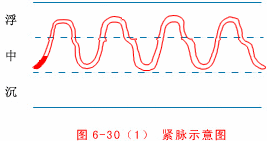 【Body Image Song】Tight pulse is strong, with a snapping sound; it is like twisting a rope, or tightening a string.【Main Disease Song】Tight indicates cold evil, also indicating various pains. Tight at cun indicates fullness and acute pain; tight at guan indicates cold damage and wheezing. Tight at chi indicates severe pain below the navel; tight at chi indicates hernia issues.☞ Slow Pulse (Huan Mai)
【Body Image Song】Tight pulse is strong, with a snapping sound; it is like twisting a rope, or tightening a string.【Main Disease Song】Tight indicates cold evil, also indicating various pains. Tight at cun indicates fullness and acute pain; tight at guan indicates cold damage and wheezing. Tight at chi indicates severe pain below the navel; tight at chi indicates hernia issues.☞ Slow Pulse (Huan Mai)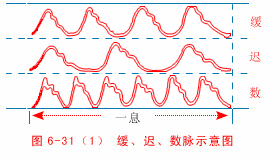 【Body Image Song】Slow pulse has four beats, coming and going evenly; like a gentle breeze, in early spring with willow trees.【Main Disease Combined Pulse Song】Slow indicates stomach qi, not indicating disease; it is necessary to observe its combination to determine the diagnosis. Floating slow indicates wind damage, deep slow indicates cold-damp. Slow large indicates wind deficiency, slow fine indicates damp obstruction. Slow rough indicates spleen deficiency, slow weak indicates qi deficiency. Right cun floating slow indicates wind evil; left cun rough slow indicates blood deficiency. Left guan floating slow indicates liver wind; right guan deep slow indicates weakness from damp invasion. Left chi slow rough indicates insufficient essence; right chi slow fine indicates extreme deficiency of true yang. ☞ String-like Pulse (Xian Mai)
【Body Image Song】Slow pulse has four beats, coming and going evenly; like a gentle breeze, in early spring with willow trees.【Main Disease Combined Pulse Song】Slow indicates stomach qi, not indicating disease; it is necessary to observe its combination to determine the diagnosis. Floating slow indicates wind damage, deep slow indicates cold-damp. Slow large indicates wind deficiency, slow fine indicates damp obstruction. Slow rough indicates spleen deficiency, slow weak indicates qi deficiency. Right cun floating slow indicates wind evil; left cun rough slow indicates blood deficiency. Left guan floating slow indicates liver wind; right guan deep slow indicates weakness from damp invasion. Left chi slow rough indicates insufficient essence; right chi slow fine indicates extreme deficiency of true yang. ☞ String-like Pulse (Xian Mai)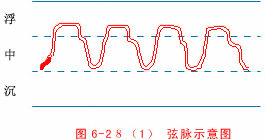 【Body Image Song】String-like pulse resembles a string of a musical instrument, light and soft; it is straight and long, with a firm touch under the fingers.【Main Disease Song】String-like indicates liver wind, indicating pain, malaria, phlegm, and fluids. String-like at left cun indicates heart pain; string-like at right cun indicates chest and head pain. String-like at left guan indicates phlegm and malaria; string-like at right guan indicates stomach cold and diaphragm pain. String-like at left chi indicates fluid in the lower jiao; string-like at right chi indicates foot cramps and hernia pain.【Combined Pulse Song】Floating string-like indicates fluid retention, deep string-like indicates suspended fluid. String-like rapid indicates heat, string-like slow indicates cold. String-like large indicates deficiency, string-like fine indicates tightness. Yang string-like indicates headache, yin string-like indicates abdominal pain. Single string-like indicates fluid retention, double string-like indicates cold accumulation.☞ Moving Pulse (Dong Mai)
【Body Image Song】String-like pulse resembles a string of a musical instrument, light and soft; it is straight and long, with a firm touch under the fingers.【Main Disease Song】String-like indicates liver wind, indicating pain, malaria, phlegm, and fluids. String-like at left cun indicates heart pain; string-like at right cun indicates chest and head pain. String-like at left guan indicates phlegm and malaria; string-like at right guan indicates stomach cold and diaphragm pain. String-like at left chi indicates fluid in the lower jiao; string-like at right chi indicates foot cramps and hernia pain.【Combined Pulse Song】Floating string-like indicates fluid retention, deep string-like indicates suspended fluid. String-like rapid indicates heat, string-like slow indicates cold. String-like large indicates deficiency, string-like fine indicates tightness. Yang string-like indicates headache, yin string-like indicates abdominal pain. Single string-like indicates fluid retention, double string-like indicates cold accumulation.☞ Moving Pulse (Dong Mai)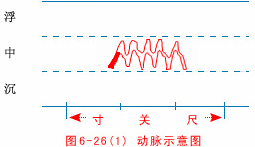 【Body Image Song】Moving pulse has no head or tail, its movement is like beans; it is erratic and must be slippery and rapid.【Main Disease Song】Moving pulse indicates pain, also indicating fright. Moving at cun indicates fright can be determined; moving at right cun indicates spontaneous sweating without doubt. Moving at left guan indicates fright and cramping; moving at right guan indicates heart and spleen pain. Moving at left chi indicates loss of essence; moving at right chi indicates rapid fire.☞ Rapid Pulse (Cu Mai)
【Body Image Song】Moving pulse has no head or tail, its movement is like beans; it is erratic and must be slippery and rapid.【Main Disease Song】Moving pulse indicates pain, also indicating fright. Moving at cun indicates fright can be determined; moving at right cun indicates spontaneous sweating without doubt. Moving at left guan indicates fright and cramping; moving at right guan indicates heart and spleen pain. Moving at left chi indicates loss of essence; moving at right chi indicates rapid fire.☞ Rapid Pulse (Cu Mai)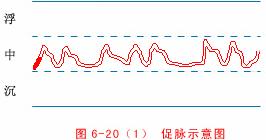 【Body Image Song】Rapid pulse is urgent, with a quick beat; like rushing and stumbling, advancing leads to death.【Main Disease Song】Rapid indicates excess fire, also due to stagnation. Rapid at cun indicates heart fire; rapid at right cun indicates lung wheezing. Rapid at left guan indicates blood stagnation; rapid at right guan indicates food stagnation. Subconscious acupoint suggests left chi indicates worry about incontinence; right chi indicates heat as a disaster.☞ Knotted Pulse (Jie Mai)
【Body Image Song】Rapid pulse is urgent, with a quick beat; like rushing and stumbling, advancing leads to death.【Main Disease Song】Rapid indicates excess fire, also due to stagnation. Rapid at cun indicates heart fire; rapid at right cun indicates lung wheezing. Rapid at left guan indicates blood stagnation; rapid at right guan indicates food stagnation. Subconscious acupoint suggests left chi indicates worry about incontinence; right chi indicates heat as a disaster.☞ Knotted Pulse (Jie Mai)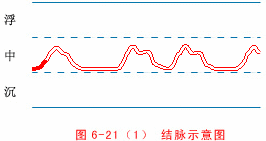 【Body Image Song】Knotted indicates a binding, pausing at intervals; moving slowly and lazily, it captures its essence.【Main Disease Song】Knotted belongs to yin-cold, also due to accumulation. Knotted at left cun indicates heart cold, pain can be determined; knotted at right cun indicates lung deficiency, with cold qi accumulation; knotted at left guan indicates hernia; knotted at right guan indicates phlegm stagnation and food retention. Knotted at left chi indicates weakness; knotted at right chi indicates yin-cold symptoms.☞ Intermittent Pulse (Dai Mai)
【Body Image Song】Knotted indicates a binding, pausing at intervals; moving slowly and lazily, it captures its essence.【Main Disease Song】Knotted belongs to yin-cold, also due to accumulation. Knotted at left cun indicates heart cold, pain can be determined; knotted at right cun indicates lung deficiency, with cold qi accumulation; knotted at left guan indicates hernia; knotted at right guan indicates phlegm stagnation and food retention. Knotted at left chi indicates weakness; knotted at right chi indicates yin-cold symptoms.☞ Intermittent Pulse (Dai Mai)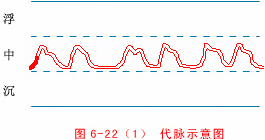 【Body Image Song】Intermittent indicates a pause, with a constant rhythm; it cannot return to itself, and takes a long time to move again.【Main Disease Song】Intermittent indicates organ decline, a sign of danger. Spleen earth is damaged, vomiting and diarrhea are punishable; internal cold leads to loss of appetite, with abdominal pain difficult to relieve. Fire palm therapy indicates two movements and one pause, three to four days leads to death; four movements and one pause leads to six to seven days of death. Sequential inquiry does not lose its essence.☞ Leather-like Pulse (Ge Mai)
【Body Image Song】Intermittent indicates a pause, with a constant rhythm; it cannot return to itself, and takes a long time to move again.【Main Disease Song】Intermittent indicates organ decline, a sign of danger. Spleen earth is damaged, vomiting and diarrhea are punishable; internal cold leads to loss of appetite, with abdominal pain difficult to relieve. Fire palm therapy indicates two movements and one pause, three to four days leads to death; four movements and one pause leads to six to seven days of death. Sequential inquiry does not lose its essence.☞ Leather-like Pulse (Ge Mai)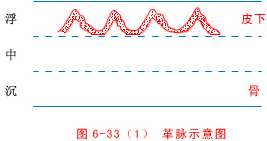 【Body Image Song】Leather-like is large and tense, easily felt when floating; pressing it reveals emptiness, like a drum skin.【Main Disease Song】Leather-like indicates exterior cold, also indicating internal deficiency. Leather-like at left cun indicates heart blood deficiency; leather-like at right cun indicates metal deficiency and qi stagnation. Leather-like at left guan indicates hernia; leather-like at right guan indicates earth deficiency and pain; leather-like at left chi indicates empty essence; leather-like at right chi indicates death as a concern. Women experiencing this may have postpartum complications.☞ Firm Pulse (Lao Mai)
【Body Image Song】Leather-like is large and tense, easily felt when floating; pressing it reveals emptiness, like a drum skin.【Main Disease Song】Leather-like indicates exterior cold, also indicating internal deficiency. Leather-like at left cun indicates heart blood deficiency; leather-like at right cun indicates metal deficiency and qi stagnation. Leather-like at left guan indicates hernia; leather-like at right guan indicates earth deficiency and pain; leather-like at left chi indicates empty essence; leather-like at right chi indicates death as a concern. Women experiencing this may have postpartum complications.☞ Firm Pulse (Lao Mai)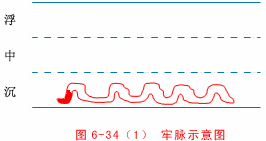 【Body Image Song】Firm pulse is found at the deep level, large and string-like; floating in the middle, it is difficult to obtain.【Main Disease Song】Firm indicates accumulation. The disease is internal. Firm at left cun indicates hidden illness; firm at right cun indicates breath regulation can be determined. Firm at left guan indicates liver blood accumulation; firm at right guan indicates yin-cold and distension. Firm at left chi indicates hernia issues; firm at right chi indicates severe pain.☞ Scattered Pulse (San Mai)
【Body Image Song】Firm pulse is found at the deep level, large and string-like; floating in the middle, it is difficult to obtain.【Main Disease Song】Firm indicates accumulation. The disease is internal. Firm at left cun indicates hidden illness; firm at right cun indicates breath regulation can be determined. Firm at left guan indicates liver blood accumulation; firm at right guan indicates yin-cold and distension. Firm at left chi indicates hernia issues; firm at right chi indicates severe pain.☞ Scattered Pulse (San Mai)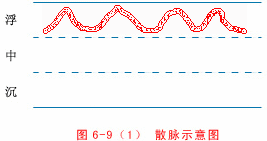 【Body Image Song】Scattered pulse is floating and chaotic, with surface but no interior; the middle level gradually empties, pressing leads to absence.【Main Disease Song】Scattered indicates fundamental injury, indicating danger. Scattered at left cun indicates palpitations and insomnia; scattered at right cun indicates spontaneous sweating. Scattered at left guan indicates excess fluid; scattered at right guan indicates fullness and illness. Located at left chi indicates northern water depletion; located at right chi indicates yang deficiency leading to death.☞ Hollow Pulse (Kao Mai)【Body Image Song】Hollow is a type of grass, resembling scallions; both floating and deep, the middle level is empty.【Main Disease Song】Hollow pulse is empty, thus indicating blood loss. Hollow at left cun indicates heart blood loss; hollow at right cun indicates yin injury. A guiding technique suggests hollow at left guan indicates liver blood not stored; hollow at right guan indicates spleen blood not retained. Hollow at left chi indicates red stools as a punishment; hollow at right chi indicates fire burning essence. ☞ Hidden Pulse (Fu Mai)
【Body Image Song】Scattered pulse is floating and chaotic, with surface but no interior; the middle level gradually empties, pressing leads to absence.【Main Disease Song】Scattered indicates fundamental injury, indicating danger. Scattered at left cun indicates palpitations and insomnia; scattered at right cun indicates spontaneous sweating. Scattered at left guan indicates excess fluid; scattered at right guan indicates fullness and illness. Located at left chi indicates northern water depletion; located at right chi indicates yang deficiency leading to death.☞ Hollow Pulse (Kao Mai)【Body Image Song】Hollow is a type of grass, resembling scallions; both floating and deep, the middle level is empty.【Main Disease Song】Hollow pulse is empty, thus indicating blood loss. Hollow at left cun indicates heart blood loss; hollow at right cun indicates yin injury. A guiding technique suggests hollow at left guan indicates liver blood not stored; hollow at right guan indicates spleen blood not retained. Hollow at left chi indicates red stools as a punishment; hollow at right chi indicates fire burning essence. ☞ Hidden Pulse (Fu Mai)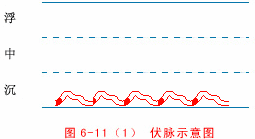 【Body Image Song】Hidden indicates concealed, deeper than deep; pressing the muscles reveals its shape.【Main Disease Song】Hidden pulse is yin, indicating deep-seated illness. Hidden at left cun indicates blood stagnation; hidden at right cun indicates qi stagnation. Hidden at left guan indicates liver blood in the abdomen; hidden at right guan indicates cold condensing water and grains. Hidden at left chi indicates hernia issues; hidden at right chi indicates diminished fire.☞ Rapid Pulse (Ji Mai)
【Body Image Song】Hidden indicates concealed, deeper than deep; pressing the muscles reveals its shape.【Main Disease Song】Hidden pulse is yin, indicating deep-seated illness. Hidden at left cun indicates blood stagnation; hidden at right cun indicates qi stagnation. Hidden at left guan indicates liver blood in the abdomen; hidden at right guan indicates cold condensing water and grains. Hidden at left chi indicates hernia issues; hidden at right chi indicates diminished fire.☞ Rapid Pulse (Ji Mai)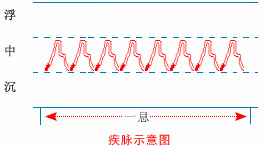 【Body Image Song】Rapid indicates extreme urgency, with the highest frequency; seven to eight beats, the pulse flows thin and rapid.【Main Disease Song】Rapid indicates extreme yang, with yin qi about to deplete; the pulse deviates from the norm, the spirit may be lost; gradually advancing rapidly, often leading to death. Rapid at left cun indicates do not suppress self-immolation; rapid at right cun indicates metal being consumed by fire. A technique suggests rapid at left guan indicates liver yin has been exhausted; rapid at right guan indicates spleen yin has been depleted. Rapid at left chi indicates difficulty in moistening; rapid at right chi indicates excessive heat.
【Body Image Song】Rapid indicates extreme urgency, with the highest frequency; seven to eight beats, the pulse flows thin and rapid.【Main Disease Song】Rapid indicates extreme yang, with yin qi about to deplete; the pulse deviates from the norm, the spirit may be lost; gradually advancing rapidly, often leading to death. Rapid at left cun indicates do not suppress self-immolation; rapid at right cun indicates metal being consumed by fire. A technique suggests rapid at left guan indicates liver yin has been exhausted; rapid at right guan indicates spleen yin has been depleted. Rapid at left chi indicates difficulty in moistening; rapid at right chi indicates excessive heat.
 — THE END —
— THE END —
⊙This article is reprinted from the internet, for reference only, copyright belongs to the original author, if there are any objections, please inform us for timely deletion.
⊙For all prescriptions or therapies mentioned in the article, please consult a physician, do not use blindly, this platform does not bear any responsibility for any consequences!
Recommended Articles
净派(无痛)挑羊毛疔截根疗法

